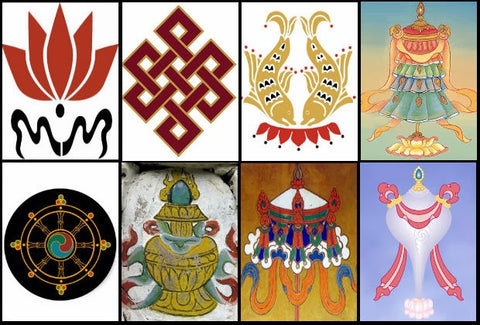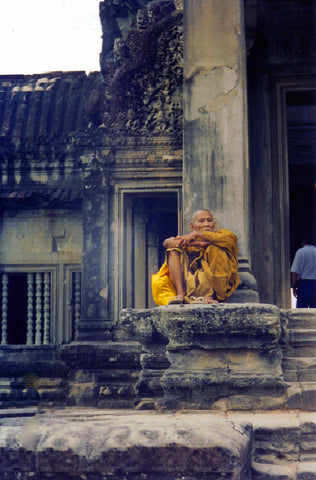Your Cart is Empty
Free Shipping for orders over $49 in Australia, $199 IN NEW ZEALAND/USA/CANADA AND $249 REST OF THE WORLD
Free Shipping for orders over $49 in Australia, $199 IN NEW ZEALAND/USA/CANADA AND $249 REST OF THE WORLD
Add description, images, menus and links to your mega menu
A column with no settings can be used as a spacer
Link to your collections, sales and even external links
Add up to five columns
Add description, images, menus and links to your mega menu
A column with no settings can be used as a spacer
Link to your collections, sales and even external links
Add up to five columns
The Astamangala or Eight Auspicious Symbols in Buddhism
by Linda Heaphy May 31, 2017

The eight auspicious symbols. Photo credit: tibetanbuddhismread
Also called the Tashitakgyad, these are a suite or group of eight symbols or attributes endemic to a number of dharmic philosophies including Buddhism, Sikhism and Jainism. They represent the enlightened mindstream and are also used as teaching tools, appearing together or singly in manuscripts and artwork and as a decorative motif on relics, statuary, buildings and jewellery. The symbols vary with the country of use (one early Indian grouping included for example a throne,swastika and handprint) and the exact nature of the philosophy being taught. The grouping has also evolved with time.
In Buddhism, the symbols often represent the gifts given by celestial beings to Shakyamuni Buddha on his attainment of enlightenment. They are:
White Parasol - protects beings from evil desires, harmful forces and illness. Traditionally a symbol of royalty, the dome of the parasol represents wisdom, while the hanging silk represents different paths to compassion.
Two Fishes - represent all beings rescued from the ocean of earthly existence. They also symbolise happiness, as the they have complete freedom of movement in the water.
Treasure Vase - also known as the vase of inexhaustible treasure, it represents the treasury of all spiritual wealth. It is depicted as an ornate golden container with lotus sections and a single wish-granting gem or a group of three gems that seal it’s opening, symbolising the Three Jewels of the Buddha, Dharma and Sanga.
Lotus - symbolising purity of the body and mind, floating above the muddy waters ofattachment and desire, as well as the progress of the soul in the attainment of enlightenment. The lotus is an important Buddhist symbol of purity as it holds a cleansing function in nature, filtering the water surrounding it but itself remaining untouched and unchanged. Many buddhas, bodhisattvas, gods and goddesses are depicted seated or standing on lotus thrones, symbolising their divine origin, perfection and purity.
Conch Shell - proclaims the glory of turning to the correct (physically, the right) spiritual path. The right-opening whiteconch, as an instrument of sound, representsdharma, awakening disciples from the deep slumber of ignorance and encouraging them to improve their welfare and the welfare of others. The conch shell is usually depicted vertically, often with a silk ribbon wrapped around it, but may also appear horizontally as a receptacle for aromatic liquids. When held in the hand, usually the left (considered the hand of wisdom), the conch shell proclaims Buddhadarma (the law of Buddha) as the aspect of speech. In Hinduism, the conch is an attribute ofVishnu, of whom Gautama Buddha is considered to be an avatar.
Endless Knot - in its most basic manifestation the endless knot represents the cycle of rebirth that all living beings must forever repeat. On another level it represents the Buddha’s endless capacity for wisdom and compassion. As a symbol of Buddha’s teaching, it symbolises the continuity of the twelve links of dependent origination, which underlies the reality of cyclic existence.
Victory Banner - a military symbol of success in warfare, the victory banner represents the victory of Buddhism over the four māras (hindrances) in the path of enlightenment - pride, desire, disturbing emotions and fear of death. Within the Tibetan tradition of Buddhism there are eleven different forms of the victory banner, representing eleven specific methods for overcoming defilement.
Wheel - also known as the dharmachakra or Wheel of Law, it represents transformation and the teachings of Gautama Buddha. The wheel’s swift motion represents the rapid spiritual transformation revealed in the Buddha’s teachings. While the wheel is used by Tibetan Buddhists, Nepalese Buddhists tend to use the fly-whisk instead, symbolising tantric manifestations.
References and Further Reading:
Ashtamangala. Wikipendia. Accessed 30th May 2017
The Eight Auspicious Symbols of Buddhism. EXPLORE TIBET. Accessed 30th May 2017
1 Response
Leave a comment
Comments will be approved before showing up.
Also in Symbols & Ritual Objects

Om Mani Padme Hum – the Mantra of Compassion
by Linda Heaphy July 03, 2017
Beliefs And Customs Buddhism Eight Auspicious Symbols Nepal Om Prayer wheel Religion Spirituality Symbology Tibet
Read More Articles
About the Author
- Linda has a Honours degree in Marine Biology and a PhD in Ecology from the University of NSW, Australia. She has travelled extensively and is a passionate writer on subjects as diverse as the role played by women throughout history, tribal communities and their customs, symbology and ethnology, talismans and their history. Occasionally she also writes about her travel experiences, her new life on a 25 acres in the Northern Rivers region of northern Australia and her black miniature poodle Phoenix. She is currently writing her first book on talismans.
About Us
-
The Kashgar Philosophy

Kashgar began through a love of travel.
In 1989 my father Bernard packed in his house painting business and set off for two years on a backpacking trek to the remotest corners of the world. When he finally arrived in the oasis city of Kashgar, China, he was so impressed with its history that he decided to start a new life collecting and selling exotic goods from all over the world. For 2000 years the legendary city of Kashgar was a melting pot of ideas and a key trading post on the historic Silk Road. It was this unique combination of philosophy and trade that my father wanted to recreate at home.
Starting in markets in 1991, he opened his first store in the Sydney suburb of Newtown in 1994. I gave up my own career as a government scientist to join him in 2000 and soon convinced my partner Ian to join us in what was to become the Family Business.
Today our version of Kashgar stocks a hugely diverse range of furniture, rugs, textiles, antiques, handicrafts and jewellery sourced from over twenty different countries including India, Nepal, Tibet, China, Thailand, Burma, Laos, the Philippines, Vietnam, Mexico, Peru, Turkey, Palestine, Syria, Afghanistan and Turkmenistan. Our collection includes contemporary and tribal silver and gold jewellery, a unique range of headhunting curios, antique Buddhist relics and a collection of one-off necklaces, earrings and bracelets that I design and create myself using the beads and jewellery making techniques of ethnic minorities from around the globe.
Kashgar is a philosophy as well as a store. We are committed to supporting traditional artisans and small village communities by selling authentic handcrafted goods which are personally collected by us. By supporting traditional methods of design and production we hope to encourage local cottage industries which have a low impact on the environment and help ethnic minorities maintain their self-sufficiency into the 21st Century. We are particularly committed to assisting women around the world and to this end have worked with several organisations including the Hua Bin Women's Union of Vietnam, the East Timorese Women's Association and Tikondane in Zambia. Time honoured means of craftsmanship and traditional ways of life are disappearing as people all over the world give up their identity in favour of jeans and T-shirts. We see our trade as a means of staving off the inevitable encroachment of the 21st century, assisting communities to decide for themselves which parts of the western world they wish to incorporate (medicine, education) and which they wish to reject (prostitution, drug production, begging and servitude to warlords). We encourage our customers to think of the handicrafts and artifacts they buy from us as an investment: a piece of history and a way of life that may soon be gone forever.
Kashgar has recently closed its retail outlet and gone completely online.
In the past our pieces appeared in many movies including The Hobbit, Mission Impossible 2, Queen of the Damned, Scooby Doo, Moulin Rouge and Wolverine, and in many televisions series, as well as in plays, commercials and exhibitions. We've found special pieces for individual customers as well as for film sets, event management companies, hotels, businesses, consulates and embassies. The uniqueness of our stock means that we are also very appealing to interior and fashion designers with a taste for the exotic.
There is something for everyone at Kashgar - collectors, the curious, those looking for a special present or for something unique to adorn the home. Most of our items are one-off specialties; other pieces we only stock in small quantities so as to continuously offer a wide and ever-changing range of interesting products. We are also packed with ideas for decorating home and work premises that will challenge your established concepts of design and storage.

Please enjoy - Linda Heaphy
Become a Kashgar nomad and join our mailing list...
Sign up to get the latest on sales, new releases and more …





catherine
March 25, 2022
thanks for your post! It is very informative.